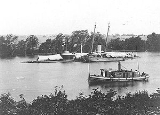
Canonicus class monitor
Encyclopedia
The Canonicus class monitors
Monitor (warship)
A monitor was a class of relatively small warship which was neither fast nor strongly armoured but carried disproportionately large guns. They were used by some navies from the 1860s until the end of World War II, and saw their final use by the United States Navy during the Vietnam War.The monitors...
of the U.S. Navy were built during the American Civil War
American Civil War
The American Civil War was a civil war fought in the United States of America. In response to the election of Abraham Lincoln as President of the United States, 11 southern slave states declared their secession from the United States and formed the Confederate States of America ; the other 25...
. They saw service in the Civil War and the Spanish-American War
Spanish-American War
The Spanish–American War was a conflict in 1898 between Spain and the United States, effectively the result of American intervention in the ongoing Cuban War of Independence...
, although two of them were never commissioned.
The ships were basically improved Passaics, with wood and iron upper and iron lower hulls, modified in accordance with war experience. Catawba
USS Catawba (1864)
USS Catawba was a Canonicus-class monitor built for the American Civil War; but completed too late to see action in that conflict. To help finance the Reconstruction, Catawba was sold to Peru.-Construction and sale:...
and Oneota
USS Oneota
USS Oneota may refer to:, a monitor built in Ohio for the American Civil War., a net laying ship built during World War II....
were named Atahuallpa and Manco Capac by the Peruvians, who acquired them in 1868. The six other ships were renamed Scylla, Castor, Ajax, Neptune, Centaur and Vesuvius on 15 June 1869. They reverted to their original names on 10 August 1869, except Ajax who kept its name and Vesuvius who became Wyandotte. The four ships not commissioned during the war were built on the Ohio river
Ohio River
The Ohio River is the largest tributary, by volume, of the Mississippi River. At the confluence, the Ohio is even bigger than the Mississippi and, thus, is hydrologically the main stream of the whole river system, including the Allegheny River further upstream...
, three at Cincinnati and Manayunk as far up as South Pittsburgh.
The hull lines were improved and designed speed is given as 13 knots but there was no hope of getting near this. The 5 × 1 in side armour was backed by two iron stringers 6½ in deep and 6 in thick for 70 ft from the bows, but 4 in elsewhere, and the armour lower edge was 3 × 1 in. The turret
Turret
In architecture, a turret is a small tower that projects vertically from the wall of a building such as a medieval castle. Turrets were used to provide a projecting defensive position allowing covering fire to the adjacent wall in the days of military fortification...
, of 21 ft internal diameter, had 10 × 1 in plates as did the pilot house above, and the funnel base was also armoured. The turret skirt was protected by a 5 in thick and 15 in high ring fixed to the deck, and as in other later monitors the 15 in guns were longer than in the Passaic class and fired with their muzzles outside the turret.
Tecumseh was sunk in Mobile Bay
Mobile Bay
Mobile Bay is an inlet of the Gulf of Mexico, lying within the state of Alabama in the United States. Its mouth is formed by the Fort Morgan Peninsula on the eastern side and Dauphin Island, a barrier island on the western side. The Mobile River and Tensaw River empty into the northern end of the...
by a mine
Naval mine
A naval mine is a self-contained explosive device placed in water to destroy surface ships or submarines. Unlike depth charges, mines are deposited and left to wait until they are triggered by the approach of, or contact with, an enemy vessel...
that exploded under her turret, and went down in 25 - 30 seconds. Canonicus, the last survivor, was finally decommissioned 31 years before being sold.
See also
Ships of the Canonicus class:- USS CanonicusUSS Canonicus (1863)|-See also:* American Civil War* Union Navy* Confederate States Navy...
- USS CatawbaUSS Catawba (1864)USS Catawba was a Canonicus-class monitor built for the American Civil War; but completed too late to see action in that conflict. To help finance the Reconstruction, Catawba was sold to Peru.-Construction and sale:...
- USS MahopacUSS Mahopac (1863)- External links :***...
- USS Manayunk
- USS ManhattanUSS Manhattan (1863)- External links :**...
- USS OneotaUSS Oneota (1864)USS Oneota, a coastal monitor built at Cincinnati, Ohio, by Alexander Swift & Co., and by the Niles Works, was launched 21 May 1864.Completed shortly after the end of the American Civil War, on 10 June 1865, Oneota was laid up until sold to her builder, Alexander Swift and Co., 13 April 1868, and...
- USS SaugusUSS Saugus (1863)USS Saugus was a monitor constructed for the Union Navy during the third year of the American Civil War. She saw most of her military action in the rivers of Virginia, including being there for the fall of Richmond, Virginia. Post-war, she was recommissioned for further service with the U.S...
- USS TecumsehUSS Tecumseh (1863)The first USS Tecumseh was an iron-hulled, single-turret monitor in the United States Navy during the American Civil War.Tecumseh was launched on 12 September 1863 at Jersey City, New Jersey, by Secor and Company,of New York City; and was commissioned at the New York Navy Yard on 19 April 1864,...
- USS Tippecanoe

